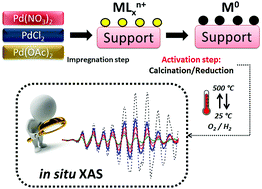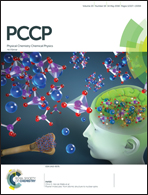An in situ XAS study of the activation of precursor-dependent Pd nanoparticles†
Abstract
The activation of precursor-dependent Pd nanoparticles was comprehensively followed by in situ X-ray absorption spectroscopy on two inorganic supports for rationalizing the final catalytic activity. Two series of Pd-based catalysts (7 wt% Pd) were prepared by impregnation of γ-Al2O3 and activated carbon supports varying the metal precursor (Pd(NO3)2, PdCl2 and Pd(OAc)2). The most relevant physicochemical properties of the studied catalysts were determined by several techniques including ICP-OES, XRD, N2 adsorption and XAS. The results indicate that the thermal stability of the metal precursor plays an important role in the size and speciation of the formed Pd nanoparticles after the activation process. The Cl-based precursor, which presents high thermal stability, passes through a PdOxCly mixed phase when submitted to calcination on Pd/Al2O3 and leaves Cl-species after metal reduction on Pd/C (which can be detrimental to catalytic reactions). Differently, Pd(OAc)2 and Pd(NO3)2 promote the formation of larger species due to different precursor decomposition pathways. Ordered PdO is observed even before calcination when Pd(NO3)2 was used as a metallic source, which translates into large nanoparticles after reduction in H2. By using the average coordination numbers of Pd species obtained from EXAFS data of the as-reduced catalysts, a correlation was observed comparing the three precursors: PdCl2 generates smaller nanoparticles than Pd(OAc)2, which in turn generates smaller nanoparticles than Pd(NO3)2, regardless of the support used for catalyst preparation.



 Please wait while we load your content...
Please wait while we load your content...